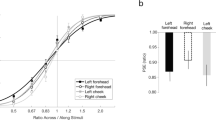Summary
The ability to discriminate the direction of movement across the skin utilizes several information categories. Spatial details, i.e., information regarding receptive field position and size of successively engaged primary afferents can be appraised relative to temporal details regarding the order of engagement. This procedure can be improved by utilization of information from other afferents signalling relative changes of lateral skin tension which are caused by friction and will appear around the moving object in the skin. The integrative nature of the directional sensibility can perhaps explain its particular susceptibility to deterioration compared to other tactile functional components.
Access this chapter
Tax calculation will be finalised at checkout
Purchases are for personal use only
Preview
Unable to display preview. Download preview PDF.
Similar content being viewed by others
References
Aubert, H. and Kammler, A. (1858) Untersuchungen über den Druck- und Raumsinn der Haut.Moleschott’s Untersuchungen zur Naturlehre, 5:145–179
Bender, M.B., Stacy, C. and Cohen, J. (1982) Agraphesthesia. A disorder of directional cutaneous kinesthesia or a disorientation in cutaneous space.Journal of the Neurological Sciences, 53:531–555
Bogen, J.E., Fisher, E.D. and Vogel, P.J. (1965) Cerebral commissurotomy: a second case report.Journal of the American Medical Association, 194:1328–1329
Edin, B.B. (1992) Quantitative analysis of static strain sensitivity in human mechanoreceptors from hairy skin.Journal of Neurophysiology, 67:1105–1113
Edin, B.B. and Abbs, J.H. (1991) Finger movement responses of cutaneous mechanoreceptors in the dorsal skin of the human hand.Journal of Neurophysiology, 65:657–670
Essick, G.K. (1992) Comprehensive clinical evaluation of perioral sensory function.Oral and Maxillofacial Surgery Clinics of North America, 4:503–526
Essick, G.K., McGuire, M., Joseph, A. and Franzén, O. (1992) Characterization of the percepts evoked by discontinuous motion over the perioral skin.Somatosensory and Motor Research, 9:175–184
Foerster, O. (1936) Die Bedeutung des Hinterstranges für die taktile Sensibilität.In: Bumke, O. and Foerster, O (eds):Handbuch der Neurologie. Verlag von Julius Springer, Berlin, pp 359–363
Gould, W.R., Vierck Jr., C.J. & Luck, M.M. (1979) Cues supporting recognition of the orientation or direction of movement of tactile stimuli.In: Kenshalo, D.R (ed):Sensory function of the skin of humans. Proceedings of the second international symposium on the skin senses, held at Florida State University, Tallahassee, Florida, June 5–7,1978. Plenum Press, New York, pp 63–73
Hall, G.S. and Donaldson, H.H. (1885) Motor sensations on the skin.Mind, 10:557–572
Hankey, G.J. and Edis, R.H. (1989) The utility of testing tactile perception of direction of scratch as a sensitive clinical sign of posterior column dysfunction in spinal cord disorders.Journal of Neurology, Neurosurgery and Psychiatry, 52:395–398
Johansson, R.S., Häger, C. and Bäckström, L. (1992) Somatosensory control of precision grip during unpredictable pulling loads: III. Impairments during digital anaesthesia.Experimental Brain Research, 89:204–213
Johansson, R.S., Häger, C. and Riso, R. (1992) Somatosensory control of precision grip during unpredictable pulling loads: II. Changes in load force rate.Experimental Brain Research, 89:192–203
Johansson, R.S., Riso, R., Häger, C. and Bäckström, L. (1992) Somatosensory control of precision grip during unpredictable pulling loads: I. Changes in load force amplitude.Experimental Brain Research, 89:181–191
Johnson, K.O. and Phillips, J.R. (1981) Tactile spatial resolution. I. Two-point discrimination, gap detection, grating resolution, and letter recognition.Journal of Neurophysiology, 46:1177–1191
Loomis, J.M. and Collins, C.C. (1978) Sensitivity to shifts of a point stimulus: an instance of tactile hyperacuity.Perception and Psychophysics, 24:487–492
Norrsell, U. (1973) Defects in tactile directional sensitivity after forebrain commissurotomy in man.Nature, 245:41–42
Norrsell, U. and Olausson, H. (1992) Human, tactile, directional sensibility and its peripheral origins.Acta Physiologica Scandinavia, 144:155–161
Norrsell, U. and Olausson, H. (1994) Spatial cues serving the tactile directional sensibility of the human forearm.Journal of Physiology, 478:533–540
Olausson, H., Kakuda, N. and Vallbo, Å. (1995) Afferent messages serving tactile directional sensibility in man.IBRO IV World Congress of Neuroscience. Kyoto, Japan
Olausson, H. and Norrsell, U. (1993) Observations on human tactile directional sensibility.Journal of Physiology, 464:545–559
Pubols Jr, B.H. (1982) Factors affecting cutaneous mechanoreceptor response. I. Constant-force versus constant-displacement stimulation.Journal of Neurophysiology, 47:515–529
Pubols Jr, B.H. and Pubols, L.M. (1983) Tactile receptor discharge and mechanical properties of glabrous skin.Federation Proceedings, 42:2528–2535
Sekuler, R., Nash, D. and Armstrong, R. (1973) Sensitive, objective procedure for evaluating response to light touch.Neurology, 23:1282–1291
Sperry, R.W., Gazzaniga, M.S. & Bogen, J.E. (1969) Interhemispheric relationships: The neocortical commissures; syndromes of hemisphere disconnection.In: Vinken, P.J. and Bruyn, G.W (eds):Handbook of Clinical Neurology. North-Holland, Amsterdam, pp 273–290.
Wall, PD. and Noordenbos, W. (1977) Sensory functions which remain in man after complete transection of dorsal columns.Brain, 100:641–653.
Author information
Authors and Affiliations
Editor information
Editors and Affiliations
Rights and permissions
Copyright information
© 1996 Birkhäuser Verlag Basel/Switzerland
About this chapter
Cite this chapter
Norrsell, U., Olausson, H. (1996). Tactile directional sensibility; theoretical and functional aspects. In: Franzén, O., Johansson, R., Terenius, L. (eds) Somesthesis and the Neurobiology of the Somatosensory Cortex. Advances in Life Sciences. Birkhäuser Basel. https://doi.org/10.1007/978-3-0348-9016-8_7
Download citation
DOI: https://doi.org/10.1007/978-3-0348-9016-8_7
Publisher Name: Birkhäuser Basel
Print ISBN: 978-3-0348-9868-3
Online ISBN: 978-3-0348-9016-8
eBook Packages: Springer Book Archive




